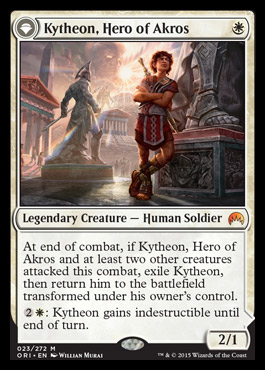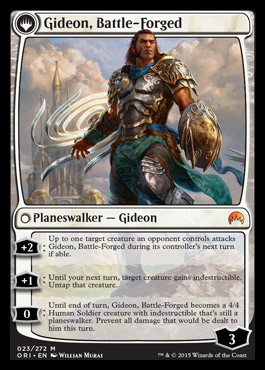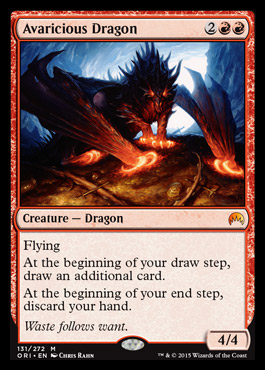I present you the last three legends that are somewhat useful as a commander:
I'm obviously leaving out this dude, but he's just plain bad (in EDH/everywhere), be it as a general or in the 99. However two of the above shown three cards aren't too exciting either. There's Dwynen, a cost-efficient elflord that also brings some extra blocking power and lifegain. And while that's definitely a card that has the potential of being a pretty good elf commander, building an elf deck is basically always the same thing regardless of the commander.
The parents of Chandra on the other hand, called Pia and Kiran, could be very interesting if it wasn't for their overly expensive ability. Bringing 4 power for 4 mana on the table while offering some additional value is pretty neat ... in standard. But unfortunately in EDH dealing 2 damage to something doesn't really do much, especially if you spent 3 mana doing so.
That leaves us with an italian demon. Let me give you the translation first:
Flying
Whenever a permanent owned by another player is put into the graveyard from the battlefield, you draw one card and lose 1 life.Not too shaby, since the effect is quite useful and he brings a solid body with evasion to the table aswell. As I've been working on a suicidal Rakdos the Defiler EDH the last couple of weeks, I'm sure to include that card into that, but I'm positive it can function as a general too. So let's see what I can come up with...
The easiest way of triggering him is of course destroying opposing permanents, but being mono-black basically limits our options to creatures:
Symmetric wrath effects would also net us a bunch of cards, but they'd also destroy our general, making him cost 8 the next time we play him. Of course I would play the symmetric ones too but only a few since I would play these cards:
While the outer two are very expensive to cast, their impact should be worth the investment. Deluge on the other hand is kind of dangerous. Obviously you should play it for a maximum of 5 life, so your general doesn't die, but if there are too many creatures on the board, paying 5 life and then drawing 10 cards and loosing another 10 life can bring you down into the danger zone pretty quickly.
Speaking of the danger zone:
Once your deck gets going, you're in for a lot of cards but you'll also loose a lot of life. To prevent dying to your "awesomeness", you should play some cards like these since each of them will net you around 15-30 life each game and that equals to 15-30 cards to be drawn without putting yourself in danger of dying all of a sudden.
Luckily there are even more synergetic cards when it comes to life combined with drawing cards...
I want to highlight the Sword and the Journal here! Managing to connect with a sword after you've drawn a chunk of cards off of a wrath or one of the "combo suicide" cards (that will get mentioned a little bit later), will not only negate all the life loss but probably net you an extra 2-4 life. Same goes for the Journal, which in addition to negating the drawback, also lets you keep all the cards in your hand, so they'll gain you even more life if the Journal keeps triggering.
And the ol' Psychosis Crawler is always there for you, so whenever you draw a card and loose a life, things stay "fair" and each opponent also looses a life. Fair, heh-hehehe-he!
In addition we have some cards that will both trigger Kothophed AND gain life making them the perfect cards for the deck:
At the beginning of my brainstorming session, I said that mono-black can only destroy creatures. That's correct 98% with 98% of the cards, but there are some very unique ones that let you interact with (other) permanents.
I especially like Smallpox here, since you'll loose three cards but draw nine (4 player game) from Kothophed while your opponents also lost three cards each. Undercity Plague and Curse of the Cabal (in suspend mode) are more consistent ways to trigger him that also allow you to manage your life total a bit better but who doesn't like drawing 9 cards and loosing 10 life for two black mana.
Just make sure your Curse of the Cabal only goes off when your life total is above 30 because you're dead quicker than you can pronounce "Phthisis" correctly - suspend is NOT a "may cast"!
And for those who don't think that's enough self-inflicted pain and want even more splashy plays, I have those bad boys in store:
Casting any one of these cards will result in three things eventually:
- You'll loose all the life
- You'll draw all the cards
- You'll loose all the friends
Let's be honest, Smokestack is probably the least "problematic" card here, but in a four player game even at two soot counters you'll have drawn three cards the first time around and 6 cards the second time for a total of nine cards and life. If you now increase it by one more soot counter, you'll loose another 9 life and draw another 9 cards and so on and so forth. It's just nasty, for you and your opponents!
Now some Pox-Math: In the average four player game, if you've cast your commander on time (turn 6) and follow it up with a Pox the next turn, your opponents will have about 6 lands on average + the occasional creature which makes for a total of 4 to 5 permanents (3-4 lands + 1 creature) sacrificed by each player. That equals to you loosing a third of your life and then an additional 12 to 15 while drawing that many cards, so if you were at 40 life you would now be at 14 ( = 40 x 0,66 - 12) or even lower. But you drew 12-15 cards so it's worth! (probably not)
Same applies to Death Cloud, even though I think it's a bit stronger just because your opponents will loose their whole hand while you just reload from the huge amount of triggers you'll get. In the above mentioned pox scenario, if you want them to discard all cards, you'll need to cast a cloud for about X = 5. With that you'll draw an amount of cards somwhere between 18 and 30 cards depending on how many creatures they had. All that will sum up for a lifeloss of 23 to 35 so even at 40 life casting a Deathcloud can be dangerous. But hey, who doesn't like to live dangerous?!
Since Kothophed will also trigger off of lands as we've elaborated, why not make that a little theme:
Combining all the lands that get sacrificed to destroy a land with Crucible of Worlds isn't much of a new tech. But drawing cards from it definitely is, especially since Crucible also serves the purpose of making "symmetric" cards like Pox or Smokestack better as we can replay our sacrificed lands.
All in all I can imagine the deck being a very unique and very interesting lockdown-control type of deck and since it is mono black that's definitely something new since most of the time these decks include Blue, Red or White but Black isn't too common.
With that I think I'm finished for today so let me ask you: Is this something you would build/play?
See y'all 'round!












































